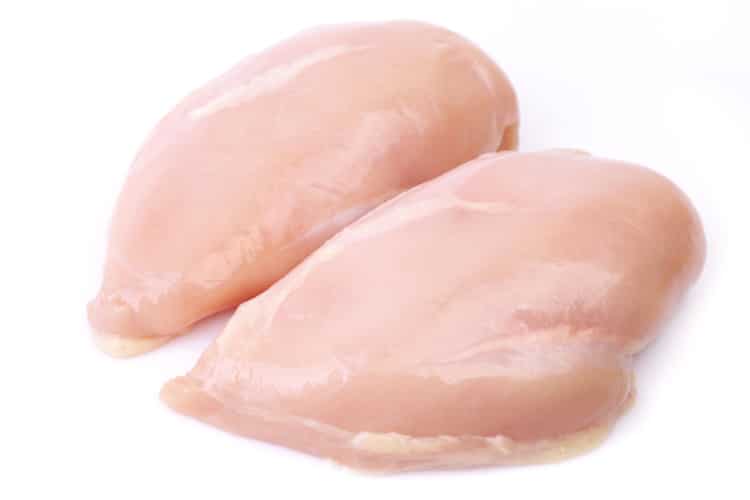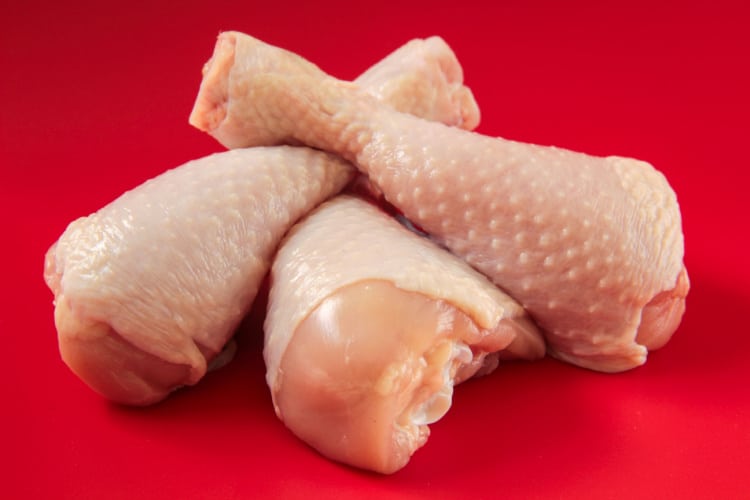While cutting your chicken, do you ever wonder why certain sections of the bird are darker than others?
It all boils down to muscular structure and myoglobin, a protein present in animal muscles that, coincidentally, is higher in dark meat muscles.
Some say dark meat is too fatty, others say white meat is dry and flavorless, but what is the real difference? In this article, we settle this delicious debate.
Difference Between White Meat and Dark Meat Chicken
The main difference between these two chicken cuts is that white meat is located in the chicken breasts and wings and includes around 10% red fibers, whereas dark meat is found in the chicken legs and contains about 50% red fibers.

But what does this mean? Well, turkey breasts are made up of fast-twitch muscle fibers, also known as “white fibers.” They are designed for brief spurts of energy and wear out fast.
The legs, on the other hand, have slow-twitch muscle fibers, also known as “red fibers.”These muscles can operate for extended periods of time and are constantly in action. So when you are enjoying chicken, you’re eating these two muscle types.
The difference in color between these muscles is due to the protein myoglobin, which is an oxygen transporter in the muscle cells. Slow-twitch muscles are used more often, so they need lots of oxygen and therefore have lots of myoglobin. On the other hand, fast-twitch muscles metabolize energy with less oxygen and myoglobin, making the meat lighter in color.
A fast-twitch muscle’s myoglobin changes color when cooked at different temperatures. As it undergoes a chemical change, the myoglobin can no longer hold oxygen, and the iron molecules at the center of the protein’s structure lose an electron.

That chemical change forms a hemichrome — that’s where the brown in medium-cooked chicken legs and thighs come from. As the heat rises, it becomes metmyoglobin, and turns the meat into a brownish-gray color.
White meat doesn’t have the myoglobin concentration to color the meat, so it looks more translucent. As it cooks, the muscle fibers, which are normally bound up in tight coils, uncoil, and the meat becomes an opaque white.
How Do They Taste Like?
Because of the way the muscles are used, white and dark chicken meat is going to taste different when cooked.
White chicken meat is generally thinner, less dense, and more tender. Consequently, this meat cooks more quickly. On the other hand, dark chicken meat is more dense, juicy, and super fatty! As a result, it takes longer to cook.
Another factor that contributes to the flavor and texture of white and dark chicken meat is the skin. Overall, white and dark chicken can be eaten with or without the skin. Leaving the skin on gives the chicken a juicier, richer flavor. It’s also a good source of nutrients, such as healthy fats.
Dark chicken meat usually comes with the skin on, plus it’s fattier by nature, so it will automatically have a richer taste and juicier texture than white chicken meat. However, keeping the skin on will add more calories to the meat. This may be an essential factor for people trying to reduce their calorie and fat consumption.
Which One Has Longer Shelf Life?
Both dark and white meat chicken meat have the same shelf life. When raw chicken is left at room temperature, harmful germs may infect it.
According to the USDA, you should not cook raw chicken that has been sitting at room temperature for more than 2 hours.
If you aren’t cooking the chicken within 2 hours, store it in a refrigerator at or below 40 degrees Fahrenheit. The USDA advises preparing raw, refrigerated chicken within a day or two.
If you’ve cooked your chicken but decided to keep it refrigerated, the USDA advises utilizing cooked chicken within 3 to 4 days at a temperature of no more than 40°F.
If left at room temperature, the meat should be cooked or consumed within two hours, whether cooked or raw.
Refrigerated chicken has a longer shelf life. Raw white or dark chicken meat may be stored in the fridge for 1 to 2 days. Cooked chicken, on the other hand, can be stored for 1 to 2 days longer.
If you don’t intend to cook or consume the chicken right away, try freezing it. Frozen cooked chicken has a shelf life of from 1 to 4 months. Frozen raw white or dark chicken can keep good quality for up to one year.
Which One Is More Expensive?
Both white and dark meat are available boneless, skinless, and bone-in. The most costly chicken parts are the boneless ones, both white and dark. This is due to the difficulty of removing chicken bone and skin, which boosts the price of the chicken by a few dollars.
You may be aware that white meat consists of the breasts and wings, whereas black meat consists of the thighs and drumsticks.
Wings and boneless chicken breast are the most expensive cuts of chicken among these. Next on the pricing list are skinless, boneless chicken thighs. The least expensive option — and, in our opinion, the tastiest — is bone-in chicken drumsticks and thighs.
White Meat vs. Dark Meat Chicken Comparison Table
| Category | White Chicken Meat | Dark Chicken Meat |
| Meat Cut | Breasts & wings | Thighs & drumsticks |
| Muscle fibers | White-fibers (fast twitch) | Red-fibers (slow twitch) |
| Presence of myoglobin | Low presence | High presence |
| Color of cooked cut | White | Brown |
| Flavor | Bland | Very flavourful |
| Texture | Dry and lean | Tender and juicier |
| Fat content | Less fat | More fat |
| Skin & bones | Sold with or without bones and skin | Sold with or without bones and skin |
| Shelf life | 2 hours at room temperatureRefrigerated raw for 1 to 2 daysRefrigerated cooked cut for 3 to 4 daysFrozen cooked cut for 1 to 4 monthsFrozen raw cut for up to 1 year | 2 hours at room temperatureRefrigerated raw for 1 to 2 daysRefrigerated cooked cut for 3 to 4 daysFrozen cooked cut for 1 to 3 monthsFrozen raw cut for up to 1 year |
| Price | More expensive | Less expensive |
Nutritional Content Breakdown: Which One Is Healthier?
Aside from the flavor, the most thorny difference between white and dark chicken meat is the amount of fat in each. White meat has fewer calories than dark meat, which contains more fat.
Additionally, white meat has more protein than dark meat and greater quantities of niacin and pyridoxine, whereas dark meat has higher levels of zinc, iron, and vitamin C.
All in all, the nutritional table below shows there are a few minor differences between these two chicken cuts, but not enough to say one is better than the other.
Even while dark meat has somewhat more fat than white meat, it also primarily includes unsaturated fat, which is beneficial to our health. The most obvious inference from this data is that both types of meat are very nutrient-dense.
White Meat vs. Dark Meat: Nutritional Profile
| Category (1 oz) | White Chicken Meat | Dark Chicken Meat |
| Calories | 47 | 66 |
| Carbs | 0g | 0g |
| Fat | 1 | 4.2g |
| Saturated fat | 0,3g | 1.2g |
| Sodium | 21mg | 28.9mg |
| Protein | 8.8g | 6.6g |
| Fiber | 0g | 0g |
| Sugars | 0g | 0g |
| Vitamins & Minerals | ||
| Calcium | 4.3mg | 2.6mg |
| Zinc | 0.3mg | 0.5mg |
| Iron | 0.3mg | 0.3mg |
| Potassium | 72.6mg | 71.7mg |
| Choline | 24.2mg | 19.2mg |
| Magnesium | 8.2mg | 6.2mg |
| Phosphorous | 64.5mg | 61.2mg |
| Vitamin B6 | 0.2mg | 0.1mg |
| Niacin | 3.9mg | 1.6mg |
Can I Substitute White Chicken Meat for Dark & Vice Versa?
Yes, you can — white chicken meat and dark chicken meat are perfect substitutions for one another in chicken recipes. When you make the swap, the most obvious difference would be the color.
However, white and dark meat also differ in fat content and cooking time. Dark chicken meat has higher fat content; thus, it’s cooked for longer. The dark flesh also consists of chicken bones, which slows the cooking down.
Longer cooking time has its perks, too, as it allows the connective tissues to transform into gelatin, which makes the meat super juicy, tender, and heavenly flavorful.
Contrarily, white chicken meat has less fat and is more easily overcooked. It is usually considered to be less flavorful and drier than dark chicken meat. However, if prepared properly, white meat may be just as juicy and tender as red meat.
Conclusion
There you go! — A holiday debate explained to make your feast that much tastier!
To sum up, dark chicken meat is a slow-twitch muscle cut. The slow-twitch fibers, commonly referred to as “red fibers,” are found in oxygen-rich muscles that work non-stop, such as the legs and thighs. The reddish appearance results from the red color of a protein known as myoglobin, an oxygen transporter in muscle cells.
On the other hand, white chicken meat is the meat of the breasts and wings, made from muscles that metabolize energy with less oxygen, which is why they’re lighter in color and have less myoglobin.
White chicken meat contains fewer calories, making it a great option for a weight-loss diet — for instance, chicken breasts, fried rice, and a fresh salad bowl. On the other hand, dark chicken meat is more juicy and flavorful, thus perfect for a chicken tortilla soup or paired with some creamy mashed potatoes.







